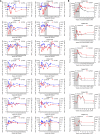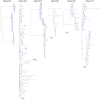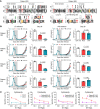Broadly neutralizing antibody-derived CAR T cells reduce viral reservoir in individuals infected with HIV-1
- PMID: 34375315
- PMCID: PMC8483761
- DOI: 10.1172/JCI150211
Broadly neutralizing antibody-derived CAR T cells reduce viral reservoir in individuals infected with HIV-1
Abstract
BACKGROUNDChimeric antigen receptor (CAR) T cells have emerged as an approach to treat malignant tumors. This strategy has also been proposed for the treatment of HIV-1 infection. We have developed a broadly neutralizing antibody-derived (bNAb-derived) CAR T cell therapy that can exert specific cytotoxic activity against HIV-1-infected cells.METHODSWe conducted an open-label trial of the safety, side-effect profile, pharmacokinetic properties, and antiviral activity of bNAb-derived CAR T cell therapy in individuals infected with HIV-1 who were undergoing analytical interruption of antiretroviral therapy (ART).RESULTSA total of 14 participants completed only a single administration of bNAb-derived CAR T cells. CAR T cell therapy administration was safe and well tolerated. Six participants discontinued ART, and viremia rebound occurred in all of them, with a 5.3-week median time. Notably, the cell-associated viral RNA and intact proviruses decreased significantly after CAR T cell treatment. Analyses of HIV-1 variants before or after CAR T cell administration suggested that CAR T cells exerted pressure on rebound viruses, resulting in a selection of viruses with less diversity and mutations against CAR T cell-mediated cytotoxicity.CONCLUSIONNo safety concerns were identified with adoptive transfer of bNAb-derived CAR T cells. They reduced viral reservoir. All the rebounds were due to preexisting or emergence of viral escape mutations.TRIAL REGISTRATIONClinicalTrials.gov (NCT03240328).FUNDINGMinistry of Science and Technology of China, National Natural Science Foundation of China, and Department of Science and Technology of Guangdong Province.
Keywords: AIDS/HIV; Clinical Trials; Immunotherapy.
Conflict of interest statement
Figures






Comment in
-
HIV-specific CAR T cells return to the clinic.J Clin Invest. 2021 Oct 1;131(19):e153204. doi: 10.1172/JCI153204. J Clin Invest. 2021. PMID: 34596054 Free PMC article.
References
Publication types
MeSH terms
Substances
Associated data
LinkOut - more resources
Full Text Sources
Other Literature Sources
Medical
Molecular Biology Databases

